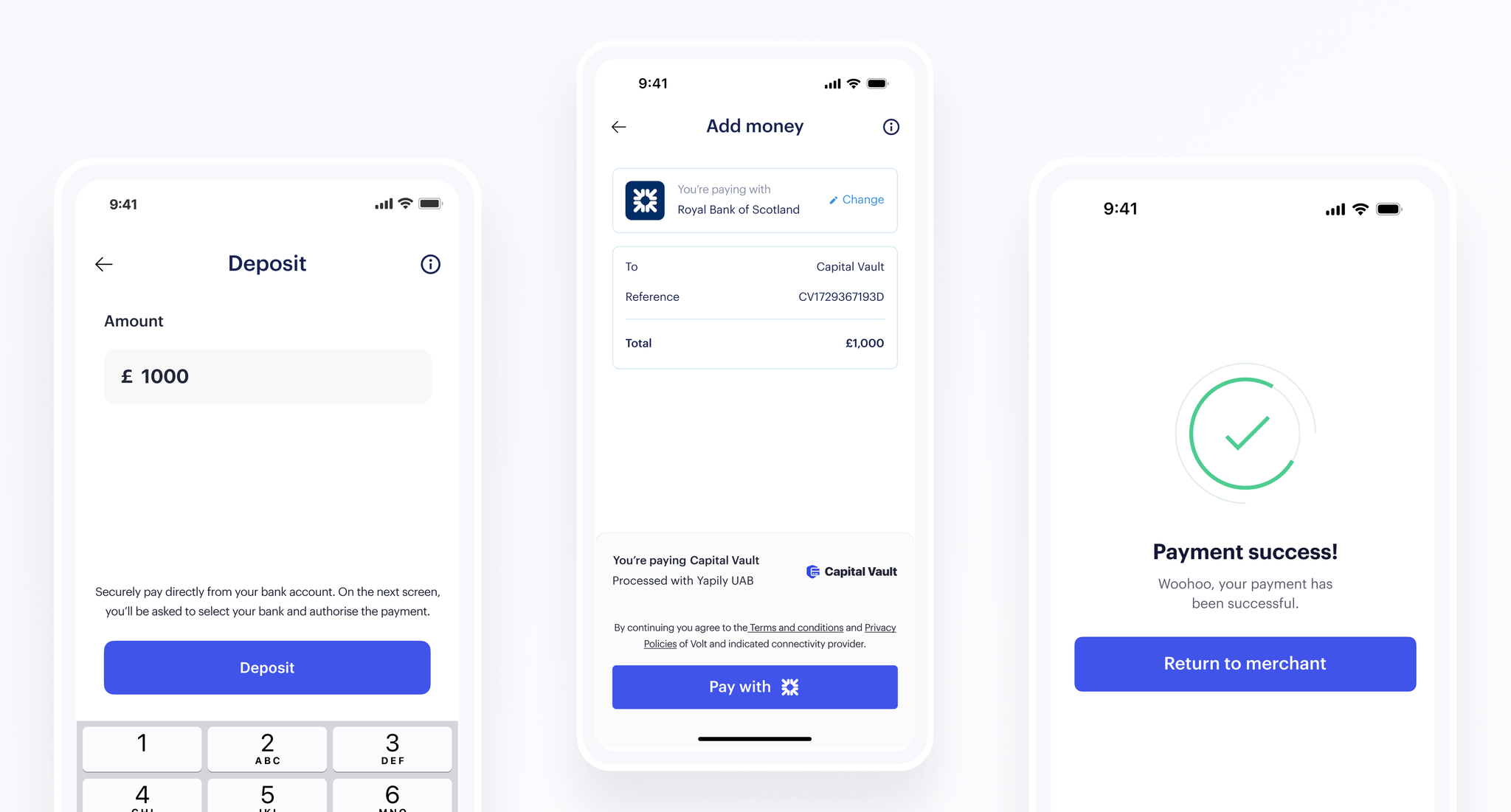


Open banking
Variable Recurring Payments: what are they and how do they work?
‘A revolution.’
‘A new era for financial services.’
‘The future of payments.’
While VRPs – variable recurring payments – have only been available since 2022, for limited and specific use cases, there’s been a lot of fighting talk about their potentially transformative impact.
But, beyond the inevitable hyperbole, what are their tangible benefits? How will they be an improvement over payment methods, like cards and direct debit, that, while not perfect, are tried and tested?
This article aims to demystify VRPs and set the record straight about this exciting technology’s current state of play.
We’ll address:
- What VRPs are and how they work
- What you can (and can’t) use VRP technology for right now
- VRPs’ most impactful use cases, and how they benefit both merchants and consumers
What are variable recurring payments (VRPs)?
A VRP is an automatic transfer of money from one account to another, made at regular intervals in accordance with specific parameters.
There are two main types: sweeping VRPs and commercial VRPs. Currently, only sweeping VRPs are available. Commercial VRPs aren’t, but are coming soon (more on this in a minute).
Like direct debits and standing orders, VRPs put repeat payments on autopilot. But they differ from direct debits and standing orders in three fundamental ways:
- They settle in real time
- There’s no need to share any account details. The customer sets up a VRP using encrypted credentials, so there’s less risk of mistakenly inputting the wrong details, or of sensitive data falling into the wrong hands
- They’re highly customisable. The customer can set specific parameters for each VRP, giving them more flexibility, transparency, and control

Sweeping VRPs
Sweeping VRPs automatically transfer – or ‘sweep’ – money from one account to another even if they’re with different providers. It’s useful to think of them as ‘me-to-me’ payments. The customer can automate transfers between accounts, as long as both accounts are in their name.
In 2021, the UK Competition and Markets Authority obliged banks to make sweeping VRP APIs publicly available for free. Despite a short delay – the compliance deadline was pushed back from January to June 2022 – the technology is now available and increasingly commonplace.
Sweeping has regulatory approval for three purposes:
- Moving money between current accounts (this includes e-money accounts, like the customer’s Revolut or Wise account, and business accounts)
- Moving money to cash-based savings accounts
- Moving money into credit accounts, like the customer’s mortgage, student loan, or credit card
If you’re a business that offers current accounts or other money management products, sweeping VRPs enable you to give your customers more value than ever before.
Your product is no longer just a commodity. Instead, you can position yourself as a trusted advisor, using smart technology to help your customers take control of their financial futures.
By tapping into Open Banking analytics, and using parameters which the customer has set ahead of time, sweeping VRPs make it possible to manage money much more effectively, with minimal intervention. Key use cases include:
- Working out how much the customer can afford to save based on their income, outgoings, and spending habits
- Moving surplus money into a savings account or cash ISA, or making mortgage or student loan overpayments
- Identifying the customer’s most expensive debts, so they can pay them off first, before they become unmanageable
- Detecting when an account is at risk of going overdrawn, and moving money into it before this happens

Commercial VRPs
If sweeping VRPs are me-to-me, commercial VRPs are me-to-business: payments from a customer’s account to yours. Think of them as a replacement for direct debit and card on file. A bank-account-on-file, if you will.
Unlike sweeping VRPs, commercial VRPs haven’t been mandated yet. But Stuart Barclay, our SVP Growth, observes that the Joint Regulatory Oversight Committee – the body responsible for implementing Open Banking in the UK – is planning a big push in the coming months:
“They’re going to develop a blueprint – a plan of action with tasks assigned to different stakeholders. And their aim is to get a commercial VRP pilot running.”
That said, Stuart continues, it’s safe to assume there will be delays. While the basic infrastructure is similar to that used by sweeping VRPs, commercial VRPs are a different proposition, because they involve payments from consumers to third parties and because banks will be charging for them.
The fact that, for the first time, banks will be playing a fundamental role in Open Banking, facilitating VRPs from consumers to merchants, is a positive development:
“It will get banks invested in this technology and in Open Banking. And I believe this will help make it truly transformative.”
The flipside is that, because this is a new way of doing things, there are issues which will need to be ironed out:
“There are things which the market needs to agree on. Liability… who is ultimately responsible for failed payments… and that’s before we get into the specifics of pricing, which will be discussed bilaterally.”
A spotlight on potential VRP use cases
While banks still need to work out the practicalities, commercial VRPs are coming. NatWest, for instance, started piloting PayIt – its commercial VRP product – in 2022.
Commercial VRPs are safer than cards or direct debit, give consumers more control, and make the payment experience much easier and smoother. Once the consumer sets up the VRP, any transaction within pre-approved parameters goes through with a single click. Further authentication steps are only necessary when a transaction falls outside those limits.

As a merchant, commercial VRPs mean fewer payment declines, lower cart abandonment, and better cash flow. And while banks will be charging transaction fees, these will likely be significantly lower and more transparent than those for card and direct debit payments.
So what are the most promising use cases for commercial VRPs?
Subscription payments
Commercial VRPs are ideally suited to subscription payments, because they’re more stable and reliable than card on file.
Unlike cards, bank account details don’t expire. And Strong Customer Authentication only takes place once, when the customer sets up the VRP, so there’s less risk of payment failures due to technical glitches.
From a customer’s point of view, VRPs also deliver a better user experience.
It’s easier to keep track of spending. The customer can set parameters so they’re alerted if the monthly price jumps over a certain amount.
Ending a subscription is also much more straightforward. Instead of going through a convoluted and opaque cancellation process, the customer simply logs on to their banking app and cancels the VRP.
E-commerce
About 70% of online shoppers abandon their cart before completing their purchase. Two of the top reasons for this are a complicated checkout process and concerns about whether the website will keep financial details safe.
Commercial VRPs make checking out swifter, smoother, and safer. There’s no need to share any sensitive details, making payments safer for both consumers and merchants. Consumers can also set maximum spending limits and pay for anything under those limits with a single click, eliminating friction from the process while keeping them in control of their spending.
Household bills
Commercial VRPs can help make household bills more manageable in two key ways.
First, if the consumer has an irregular income or gets paid other than once a month, commercial VRPs can manage bills in the way that makes most sense for their financial circumstances.
They could set money aside at regular intervals and pay off the bill at the end of the month, for instance. Or payment could be split into several instalments that coincide with the dates when they receive their salary.
This is a win-win. Customers don't miss payment or suffer financial hardship because bills are due at the wrong time of the month. And as a merchant, you don’t have to start costly, time-consuming debt collection proceedings that undermine your relationship with the customer and worsen their financial woes.
Second, commercial VRPs can help make bills more affordable.
Consider utilities. Instead of setting up an arbitrary direct debit amount and having to revisit it at regular intervals, commercial VRPs make it possible to pay for actual consumption.
Grocery deliveries
Commercial VRPs make paying for deliveries much easier. The customer can pre-authorise payments within predetermined limits, so they don’t have to leave a card on file or key in their payment details every time they place an order.
Substitutions are also much more straightforward. As a merchant, you don’t have to wait for the customer to accept the substitution and work out the final bills. Instead, you can take a variable amount out of the consumer’s account at the point of delivery.
Business taxes
If you’re a business, commercial VRPs can dynamically set money aside for corporation tax, income tax, VAT, and other deductions whenever a customer buys one of your products or pays an invoice.
This could be especially beneficial for small businesses, which often struggle to pay their tax bills due to cashflow issues or because they’ve miscalculated their liability.
But bigger businesses stand to benefit too, because automating the process can save time and free up resources.
Looking ahead: VRPs can redefine the consumer-merchant relationship
In payments, there’s often tension between security and convenience. This was true back when consumers paid for goods by bartering. And it’s even more true now that they pay for most transactions using cashless methods.
Research suggests that, increasingly, consumers would rather not share any personal financial details when they pay. But, equally, nobody likes to fill out lengthy forms and jump through needless hoops in the name of security. Fast, easy payments are the name of the game.
Where traditional payment methods like direct debit and cards make juggling these two competing interests feel like trying to square a circle, VRPs offer the best of both worlds. A more secure payment experience that’s also quick and seamless.
But the change VRPs promise is even more fundamental than this: a redrawing of the relationship between consumers and merchants. This is a positive step forward for both sides.
Consumers will be more financially empowered than they’ve ever been. And, as for merchants, payments will no longer be a risk and a cost centre, but a way to build stronger, longer-lasting relationships with those you serve.
More like this

Open banking
Industry deep dive: Exploring player behaviour trends in eGaming
We uncover the latest player habits shaping the eGaming landscape, and how open banking delivers on the demand for superior in-game payment processes.

Open banking
How much are card fees: A complete guide to processing costs
From interchange fees to scheme costs, we explore the full set of expenses that come with accepting card payments - and how they can be avoided through open banking.

Market insights
From screen scraping to PSD3: The growth of open banking in DACH
We look at open banking in DACH, starting with the German Federal Post Office’s experience to the upcoming PSD3 and Payment Services Regulation.